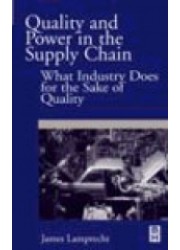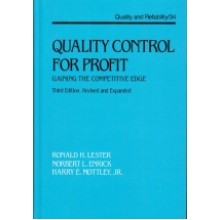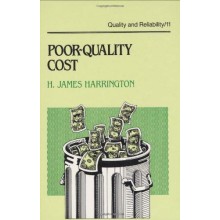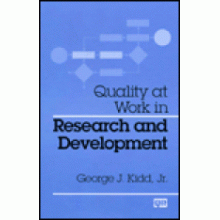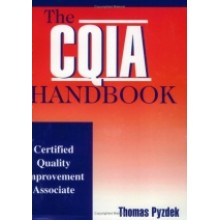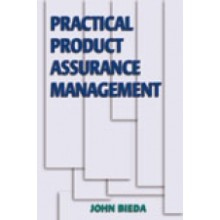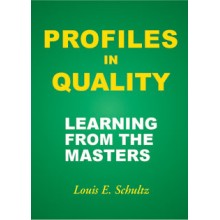Quality and Power in the Supply Chain: What Industry does for the Sake of Quality
ISBN: 9780750673433
Author: James Lamprecht
Dispatch Time: 2 - 3 Days
Quantity:
-
Add to Compare
This book reconciles two divergent worlds for the beleaguered quality manager. The first is that of quality and managerial fads, promoted by quality professionals and the quality 'industry' - with its seminars, certification programs and the pressures of an ever increasing number of international standards, state and national legislation and powerful corporations. The second is a virtual antithesis to this world of mission statements, quality policies, procedures and statistical techniques, and is embodied in the international phenomenon that is the Dilbert (TM) cartoon strip. Across America and Europe millions of ordinary employees revel in the truths that are exposed concerning corporate absurdities and a blind reliance upon acronym-laden quick-fixes.
Here you will find the gap bridged between the vast literature of quality fads (including the recent tranche of international standards) and that more humorous portrayal of these worlds. The origins of today's quality ideology and industry is traced, followed by a description of how the quality profession popularizes, promotes and ultimately benefits from the fads that come and go. Finally it is shown that despite the propaganda of the profession, there is a separate reality to "quality" and that management principles in this field can only ever be a small limiting factor in corporate success.
List of Tables
Preface
Part I: Prologue: On Power and Its Impact on Customer-Supplier Relations
Chapter 1. Power and its Impact on Customer Supplier Relation
Introduction
The role of power in dictating demands
The Vendor-Vendee Relationship within the Automotive Sector: U.S. vs. Japan
Dual Economy in the World of International Standards
Chapter 2. On Registrars and Bureaucratic Power
Constraints and absurdity
Types of Organizations
Registrars as a mixture of Craft and Procedural bureaucracies
Virtual ISO Certification: Guaranteed, Cheap and E-Z
Part II: The Limits of Quality: Essays on a Separate Reality
Chapter 3. Thoughts on the Relativity of Quality
The Zen of Quality
Is there a universal approach to management?
Are there universal principals of quality?
Can Quality be Translated?
Quality: Absolute or relative?
When a smile is a sign of inferiority
Conclusion
Chapter 4. How Old Can a Company Hope to be?
Chapter 5. Built to Last for a While: The Age of Flexibility
Flexibility and Competitiveness
Economic Success of the Firm: Is it solely based on quality issues?
Quality: one small element to economic viability
G.H. Bass vs Vita Needle Co.
The Dilemma of Responsiveness
Conclusion
Chapter 6. On Servicing the Customer Who is the customer?
Who is the Customer? The Case of ISO 9001:2000
Should all customers be treated like Kings?
Chapter 7. Fads, Incompetence, Ignorance and Stupidity
Introduction
On Stupidity
Federal Nonsense
The Case of the Truck rental agency
Partial Quality and the French Public Transportation System
Can You Sell Less Quality?
Are benchmarks always conducted to better serve the customer?
On Quality Fads
Ignorance: The leading cause of absurd behavior
On Incompetence
On the limitations of Mission Statements
Side effects of Exceeding Expectations
When Too Much Quality Leads to Ludicrous Scenarios?
The Routine of Quality
Conclusion
PART III: Colbertism and the Dawn of Power in Customer-Supplier Relations
Chapter 8. Colbertism: The Dawn of Regulatory Practices
Colbertism: The Dawn of Modern Government Regulation
Overview of the French Economic System During the 17th Century
The Colbert System
Colbert's Rules for Inspectors of August 13, 1669
Problems with Colbert's System of Regulation
Chapter 9. The Quest for Repeatability: The Emergence of Factory Organization and Standardization
Military Mass-Production
The Managerial Revolution (1840-1880): Regulation from Within
Adoption of the Armory System for Private Production
Controlling the Means of Production prior to WWI: The Age of Taylorism
Controlling the Means of Production: The inter war years (1915-1939)
The Emergence of the Government as Customer
The Role and Influence of the Military as Customer of Last Resort
Chapter 10. Military as Customer and Controller of Subcontractors
Origins of MIL-Q-5923
Justification for 5923
Early Resistance to 5923
The Omnipresent Customer
Bureaucratic Authority vs Heavenly Power
Introduction to Part IV
Part IV: The Age of Standardization
Chapter 11. The Value of Standardization: Point Counterpoint
Introduction
The Value of Standards
Origins of the International Organization for Standardization
Regulations: Who are the interested parties?
The Economics of Standardization
The Limits of Standardization
Standards and the Law: Powerful Combination
Standards Proliferation in an Age of Regulation
Will it Ever End?
Conclusion
Chapter 12. The ISO 9000 Phenomenon and The Privatization of Military Standards
Was There Quality Before ISO 9000?
Antecedents to the ISO 9000 Movement
The Need for Quick Fixes
The ISO 9000 Phenomenon: A Case Study in the Manufacturing of Consent
The ISO 9000 Series
Origins of the ISO 9000 Standards
5923, 9858 and ISO 9000: Deja vu!
Evolution of the ISO 9000 Movement in the U.S.
The Universal Language of quality 190
What Others Have Said About the Series
Evolution of the ISO 9000 Series
Was ISO 9000 a Fad?
Is ISO 9000 a legitimate paradigm for the 21st Century?
Chapter 13. Quality Professionalism and the Ideology of Control
What is professionalism?
The Ideology of Quality
Influence of the Military and the Ideology of Quality Control
Influence of the Military on the Perception of Quality
The Role of the ASQ(C) in Promoting Supplier Regulations
Recent Trends: The Ideology of Management (soft quality)
The Quality Function and the Economy of the Firm
Conclusion
Part V: Consequences of Standardization
Chapter 14. On The Origin of Procedures
Procedures during the dawn of Industrialization
Heritage of the American System
Procedures: anathema, panacea or placebo
On Working Knowledge
Chapter 15. Writing Procedures
Introduction
Frederick Winslow Taylor on Procedures
Herbert Simon on Decisions
Some Examples of Dubious Procedures
Should you never deviate from a procedure?
Should all processes be repeatable?
What is the best way to document a process?
Can (should?) procedures be written for all possible scenarios? Procedures vs. "show me"?
Types of procedures
What to Do?
Do we need special software packages to document our processes?
Are procedures required for all industries?
Should procedures be written like a computer program?
Summary and Conclusion to Parts III-V
PART VI: Conclusion
Introduction
Chapter 16. By Way of Conclusion: Dos and Don'ts
Challenges of the 21st Century: General conclusions
For the quality professional
Need to integrate many methods For companies
Final Thoughts on Don'ts
What to do How to Simplify?
ISO 9000 Software: No panacea On quality speak
Teamwork: Another view
Smaller would be better
Write a review
Your Name:Your Review: Note: HTML is not translated!
Rating: Bad Good
Enter the code in the box below:
Copyright © 2014 Engineering Standards Bureau. All Rights Reserved.
Developed By Zoom Into Web


